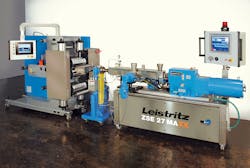Leistritz extruders cleared to make post-consumer PET sheet for food packaging
By Bruce Geiselman
Leistritz has received a letter of no objection from the U.S. Food and Drug Administration allowing post-consumer PET recycled in the company’s “super clean process” to be used in packaging that contacts food.
“It’s a confirmation the Leistritz twin-screw extrusion technology is suited for this process and application,” said Charlie Martin, president and GM of Leistritz Extrusion in Somerville, N.J.
“We have about 30 co-rotating intermeshing twin-screw extruder systems [in North America] processing undried PET into sheet for packaging applications,” Martin said. “There are many more around the world.”
The letter from the FDA, dated May 11, confirmed the ability of Leistritz’s secondary “super clean” recycling process to produce post-consumer PET sheet that is suitable for food-contact applications.
To meet the agency’s requirements, the process had to result in recyclate that would allow a contamination level of fewer than 0.5 parts per billion to migrate into food. The agency specified that the recyclate must be produced from food-grade PET containers.
“Therefore, we conclude that the finished PCR-PET material may be used at levels of up to 100 percent recycled content in manufacture of PET containers for all food types,” the FDA wrote.
The Fraunhofer Institute for Process Engineering and Packaging IVV in Freising, Germany, an R&D institute, conducted testing that helped Leistritz obtain its letter of no objection.
Contact:
Leistritz Extrusion, Somerville, N.J., 908-685-2333, https://extruders.leistritz.com
Bruce Geiselman, senior staff reporter
About the Author
Bruce Geiselman
Senior Staff Reporter Bruce Geiselman covers extrusion, blow molding, additive manufacturing, automation and end markets including automotive and packaging. He also writes features, including In Other Words and Problem Solved, for Plastics Machinery & Manufacturing, Plastics Recycling and The Journal of Blow Molding. He has extensive experience in daily and magazine journalism.
